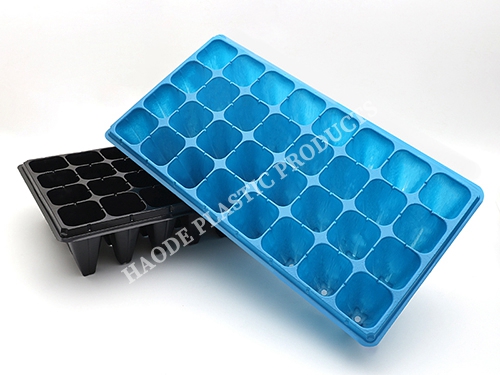
PET Seedling trays
info@haodeseedtray.com
sales@haodeseedtray.com
PET plant seedling tray, also known as plug tray, has become an important tool in the factory seedling production process. Whether it is flowers or vegetables, plug tray seedling cultivation is the most fundamental change in modern horticulture. The materials used to make plug trays are generally polystyrene foam, polystyrene, polyvinyl chloride and polypropylene. The manufacturing methods include blow molding and injection molding. General vegetable and ornamental plant seedling trays are made of polystyrene materials.
The hole shapes of seedling trays are mainly square and round. The square holes generally contain about 30% more matrix than the round holes, and the water distribution is also more uniform, and the seedling root system is fully developed. The size of the standard plug tray is 540mm×280mm. Due to the different hole diameters, the number of holes is between 18-800. For cultivating medium and small seedlings, 72--288 hole trays are suitable.
The color of the seedling tray will affect the temperature of the plant roots. White polystyrene foam trays have good reflectivity and are mostly used for early seedling cultivation in summer and autumn to reflect light and reduce heat accumulation at the roots of seedlings. In winter and spring, black pet plant seedling trays are chosen because they have good light absorption, which is beneficial to the greening of the roots of seedlings. When the seedlings grow up, root control seedling cultivation technology should be used and they should be moved into root control seedling containers to continue growing.
The materials used to make plug trays are generally polystyrene foam, polystyrene, polyvinyl chloride and polypropylene. The manufacturing methods include blow molding and injection molding. Generally, vegetable and ornamental plant seedling plug trays are made of polystyrene.
Advantages of using plug tray seedlings:
(1) Save seed usage and reduce production costs.
(2) The seedlings emerge neatly and maintain the consistency of plant seedling growth.
(3) It can be used in conjunction with various manual and automatic seeding machines, which is convenient for centralized management and improves work efficiency.
(4) The roots are not damaged during transplanting, the seedlings grow quickly and the survival rate is high.
Combining Drainage Mats with Heating Mats for Faster Germination
Learn how integrating drainage mats with heating mats improves moisture control, root aerat ...
2025-12-04
Airflow in Seedling Trays: Preventing Mold and Rot
Discover how optimized airflow in seedling trays helps prevent mold, dampness, and root rot ...
2025-12-03
How AI Is Changing Automatic Seedling Seeding Technology
Discover how AI innovation is reshaping the performance, accuracy, and reliability of the a ...
2025-12-02
Trays for Hydroponic Seed Starting: A Complete Beginner’s Guide
Discover everything beginners need to know about trays for hydroponic seed starting. Learn ...
2025-11-30




